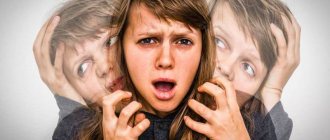Reasons ↑
The development of the disorder can be given impetus only by one strong stressful circumstance, or by several long-term psychotraumatic situations that gradually awaken fear neurosis.
There are three groups of main factors that can influence the development of the disease.
- Stress occurs when a person cannot control certain aspects of public or personal life (loss of a job, family discord, unrequited love, misunderstanding from others, etc.).
- Stressful events in life are situations when a person is required to show control over his emotions (an exam, the first visit to kindergarten or school, moving, changing jobs, the birth of a child, the loss of a loved one, and others).
- Hereditary predisposition - a person may be born with a tendency to increased anxiety. If there is a lot of stress and difficult circumstances in his life, then anxiety neurosis will certainly arise.
Symptoms of fear neurosis ↑
Fear neurosis is manifested not only by changes in behavior. It affects the entire body as a whole, affecting health and vital processes in the body.
The main mental symptoms of the disease include:
- anxiety;
- fear;
- agitation (restlessness manifested in excessive movement or talkativeness);
- depression;
- obsessive thoughts;
- hypochondria (fear for one's health);
- insomnia or increased sleepiness;
- aggression – harm to physical or psychological health;
- Nail biting and thumb sucking are common in children.
Somatic manifestations:
- headache;
- dizziness;
- increased heart rate (more than 90 beats per minute);
- hypertension or hypotension;
- heart rhythm disturbance;
- breathing problems (need to breathe deeply);
- dyspnea;
- nausea;
- constipation or diarrhea;
- feeling of trembling;
- chills;
- loss of appetite;
- tinnitus;
- enuresis.
How to treat ↑
Unfortunately, many patients with anxiety neurosis turn to a specialist too late. They either go to the therapist complaining of headaches or perceived ailments, or they self-medicate without worrying too much about their health.
If you notice one or more of the above symptoms in yourself or a loved one, you should immediately consult a psychiatrist.
Treatment takes place in two stages:
- Psychotherapy.
- Prescribing medications.
Psychotherapy methods
Psychotherapy is used for mild neurosis. The main criterion for success in treatment is the establishment of a trusting relationship between the doctor and the patient.
The psychotherapist must find out the circumstances that led to the appearance of neurosis, and also find a path to healing using psychotherapeutic methods:
- Conviction is a change in the patient’s attitude towards the situation that caused the disease. In the case of successful psychotherapy, fears and anxieties lose their significance.
- Direct suggestion is an impact on the patient’s consciousness through verbal or emotional constructions (for example: “I’ll count to five and it will happen...”, “You came to me, sit now in this soft chair, listen to my voice, today you will feel much better,” “ Your unconscious will place everything that is needed in its place."
- Indirect suggestion is the use of an additional stimulus (prescribing a homeopathic remedy or a physiotherapeutic procedure). The patient, in this case, will associate success in treatment with him.
- Self-hypnosis is information addressed to oneself. It allows you to evoke the sensations and emotions necessary for treatment, as well as pictures from the past.
- Autogenic training is the use of muscle relaxation, through which the restoration of control over the patient’s health is achieved.
- Therapy will be more effective in combination with other methods of eliminating mild forms of neurosis, such as therapeutic exercises, massage sessions and hardening.
Does anxiety persist for no apparent reason? Learn all about obsessive fears. What are the causes of social fears in adolescents? Read here.
Medications
In the mid-twentieth century, two drugs were used to treat neuroses, including anxiety, - sodium bromide and potassium bromide as a sedative, and caffeine, which in large doses can depress the nervous system.
Today, psychotherapists are using new tools that can defeat neurosis.
Tranquilizers
- aimed at relieving emotional stress, feelings of anxiety and fear, they have a calming and hypnotic effect;
- have a pronounced anti-anxiety, antiphobic effect, and also reduce muscle tone;
- relieve (prevent) all types of anxiety in neuroses, panic attacks, sleep disorders, obsessive-compulsive disorder with the presence of rituals (movements invented by the patient to protect against their fears, as well as to calm them down);
- relieve somatic symptoms such as nausea, dizziness, sweating and fever.
Antidepressants
Such medications reduce feelings of melancholy, lethargy, anxiety and apathy, increase mood, activity, improve sleep and appetite.
Used in the treatment of diseases with depressive symptoms:
- Tricyclic antidepressants - amitriptyline, imipramine. Treatment begins with a small dose of the drug, which increases over time. The effect of such drugs is visible after 1.5-2 weeks of use.
- Selective serotonin reuptake inhibitors are fluoxetine, sertraline, paroxetine and citalopram. This is the latest generation of antidepressants. They have minimal side effects and are effective only with long-term use.
- Herbal preparations are produced on the basis of St. John's wort. They can be bought at a pharmacy without a prescription, but such antidepressants have many special instructions, for example, prohibiting visiting the solarium and the beach, as well as drinking alcohol.
It should be noted that all medications must be used after consulting a doctor. Only a specialist can correctly diagnose and prescribe treatment.

Content
- 1 Causes and mechanics of the development of neurosis
- 2 Selection criteria
- 3 Symptoms 3.1 Mental symptoms
- 3.2 Physical symptoms
- 4.1 Headache
Neurosis
,
psychoneurosis
,
neurotic disorder
(Novolat. neurosis from ancient Greek νεῦρον “nerve”) is an outdated name for a group of neuropsychic disorders that arise due to acute and chronic psychological trauma and are characterized by the absence of qualitative changes in mental activity [1]. The clinical picture of such disorders is characterized by asthenic, obsessive or hysterical manifestations, as well as a temporary decrease in mental and physical performance [2].
The psychogenic factor in all cases is conflicts (external or internal), the action of circumstances causing psychological trauma, stress or prolonged overstrain of the emotional and intellectual spheres of the psyche [2].
The concept of “neurosis” was introduced into medicine in 1776 by Scottish physician William Cullen. The content of the term has been revised several times; the term still does not have an unambiguous generally accepted definition. It should also be borne in mind that in medicine and biology, “neurosis” can be called various functional disorders of higher nervous activity.
Mental disorders have traditionally been differentiated into neuroses and psychoses. Unlike psychotic disorders, with neuroses people are critical of their disorder and are able to control their actions [1].
The term "neurosis" is no longer used by the professional psychiatric community in the United States of America[3]. In the American Diagnostic and Statistical Manual of Mental Disorders, the section on “neuroses” was abolished from the third edition of DSM-III in 1980. For example, depressive neurosis was replaced by dysthymic disorder, obsessive-compulsive neurosis by obsessive-compulsive disorder, hypochondriacal neurosis by hypochondria, etc.[4]. Since the tenth revision of the International Classification of Diseases (ICD-10), the traditional differentiation between neuroses and psychoses is also no longer applied. However, the term “neurotic” is used in the title of the section (group) of mental disorders “Neurotic, stress-related, and somatoform disorders” (codes 40.-48.)[5].
Childhood anxiety neurosis ↑
The main causes of childhood fear neurosis are conflicts in the family or with peers, and less often - physical trauma, serious illness or severe fear.
If a child has recently experienced one of the above circumstances, it is necessary to be attentive to his mental state.
Parents should be concerned about the following manifestations of the disease in children:
- constant anxiety;
- obsessive fears (fear of death, darkness);
- emotional depression;
- chronic fatigue;
- frequent hysterical crying for no serious reason;
- tics and stuttering.
Do you panic at the sight of the ocean? Find out how to overcome your fear of big water. How to treat fear of closed spaces? Read the article.
What to do with fear for the future? Read on.
Treatment methods for childhood anxiety neurosis differ from those used for adults. Psychotherapists rarely use medication, but more often use the following methods:
- Art therapy is a method of treatment using artistic creativity (drawing, modeling, writing). This is a very effective and, at the same time, safe method. Art therapy affects the psycho-emotional state of the child, resolving all internal conflicts. This method promotes the development of self-expression and self-knowledge. With the help of creativity, the child depicts his inner fears, which leads to their gradual disappearance.
- Family therapy is training all family members to interact correctly with each other. Psychotherapists who use this method are convinced that the sources of neurosis lie in family relationships, so the patient can only be cured if the cause is removed.
With timely diagnosis and proper treatment, anxiety neurosis has a favorable outcome. But no less important is the support and understanding from loved ones.
What is hysteria

What is hysteria
Conversion and dissociative disorders (“hysteria”) - may look like a physical illness, but have no physical basis. This disorder does not occur intentionally, but on a subconscious level. Although the symptoms of this disorder are not specifically reproduced, they represent a person's thoughts about his disease.
With these disorders, the patient receives some benefit. The primary benefit is that anxiety is displaced from the patient's consciousness. Secondary benefit is expressed in relief from burdensome responsibilities or receiving additional attention and care.
These disorders can manifest in various movement disorders:
- paralysis,
- gait disturbance,
- trembling limbs,
- mute.
Perception disorders:
- hyperesthesia (increased sensitivity to pain),
- blindness (total or “tunnel” vision),
- deafness,
- convulsions (“hysterical arc”).
Mental symptoms:
- amnesia (memory loss),
- psychogenic fugue (wandering with memory loss),
- pseudodementia (intellectual impairment),
- stupor (lack of mobility and reactions to stimuli),
- multiple personality (the presence of two patterns of behavior, usually contrasting, while the patient forgets what the other person did).








